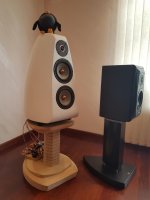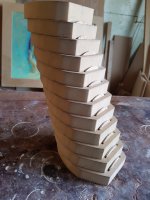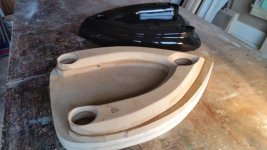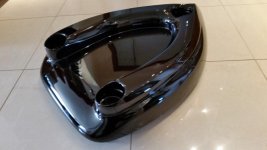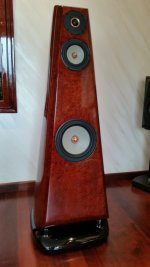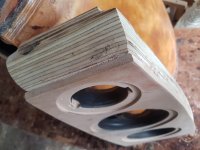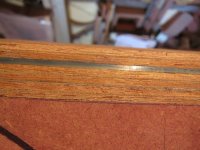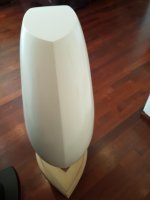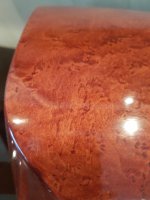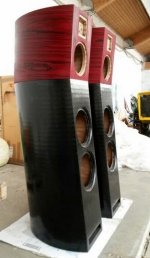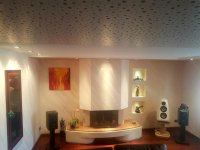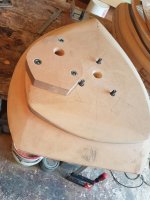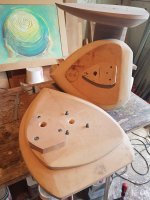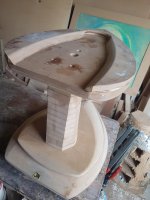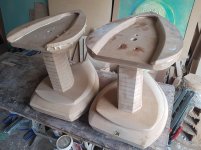Clarification, this is a polyurethane primer, follows the cabinet's veneer with "Birds of Maple".
Noted. Look forward to pics of the "final product".
Noted. Look forward to pics of the "final product".
Will have.
After the measurements, this is are Technical data:
Frequence Range; 33-25000 Hz
Long term Max Power; 200 W
Crossover Frequency; 2800 Hz
Impedance; 4 Ohms
Sensitivity; 90 db SPL
Cabinet Volume; 31 L
Gross weight / without stand /; 27kg.
This is the project of the rear speakers, will finish it with "Bird's eye view". There will be a sequel ...sometime..
Joro Raitchev
Sofia- Bulgaria
Frequence Range; 33-25000 Hz
Long term Max Power; 200 W
Crossover Frequency; 2800 Hz
Impedance; 4 Ohms
Sensitivity; 90 db SPL
Cabinet Volume; 31 L
Gross weight / without stand /; 27kg.
This is the project of the rear speakers, will finish it with "Bird's eye view". There will be a sequel ...sometime..
Joro Raitchev
Sofia- Bulgaria
A very underestimated moment - work with multilayer MDF!
There's still a lot of work on the stands.
I show you a few pictures of the front speaker bases, the rear speaker stands will look like the same;Always been a problem with the MDF, especially when we have a multilayer construction. Over time, individual parts are beginning to show up - all of this is the result of improper processing. Soon I will show you how to deal with this problem.
Always been a problem with the MDF, especially when we have a multilayer construction. Over time, individual parts are beginning to show up - all of this is the result of improper processing. Soon I will show you how to deal with this problem.
There's still a lot of work on the stands.
I show you a few pictures of the front speaker bases, the rear speaker stands will look like the same;Always been a problem with the MDF, especially when we have a multilayer construction. Over time, individual parts are beginning to show up - all of this is the result of improper processing. Soon I will show you how to deal with this problem.
Always been a problem with the MDF, especially when we have a multilayer construction. Over time, individual parts are beginning to show up - all of this is the result of improper processing. Soon I will show you how to deal with this problem.
Attachments
I noticed that I failed to share with you a very substantial detail in the construction of the front panel - type sandwich, finishing it with 6 mm MDF.
Sorry, this is a very important detail!
Some constructors use an array when building the front panel - a big mistake!
Тhe combination of plywood and MDF is a good solution.
Sorry, this is a very important detail!
Some constructors use an array when building the front panel - a big mistake!
Тhe combination of plywood and MDF is a good solution.
Attachments
And a risky picture (everything is supported by gravity), how look for compared to the front speakers, are not on one line, but I rely on your imagination.
When will you talk about sound quality? Sound comparison between the two speakers?
I have always had difficulty choosing between those two constructions.
With floor stander type, I want the second woofer to be very close to the floor (closer than what you have chosen) to improve performance, but decrease the quality of the look.
A bookshelf to me look prettier (with good stand) and tend to give better midrange.
Just stumbled upon this thread and I am impressed.
Wow! This is super work! Does the glossy finish make finger prints visible?
How much volume will you need for 2 10" woofers?
Your bracing work is insane! B&W used to advertise this bracing for their 800 Matrix series.
I too use a sandwich. 6mm marine grade ply + 4mm MDF + 2mm Fiberglass + 3mm Lead + 2m Fiberglass + 4mm MDF + 6mm ply - total 27mm plus 1.5 mm for the veneer. See pic below.
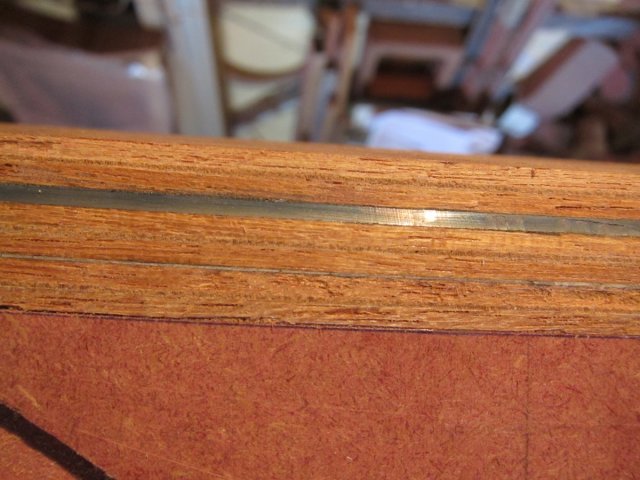
I find 4mm MDF bends about as easily as 6mm of marine grade plywood.
BTW do you have any issues with the SEAS Excel Magnesium woofers. I am having a lot of corrosion on the cones. See link. Corrosion SEAS Magnesium Drivers
I have written to SEAS but they are on holiday till Jan 2nd.
The loudspeakers are "SEAS"- Excel / Tw-1”, Mw-5”for center 2х 5.5”,Bass-8,5”/ and cross-over parts- "Intertechnik".
Wow! This is super work! Does the glossy finish make finger prints visible?
I have an idea to make a new project to in the base there should be two 10" loudspeakers - just an idea. They look like animals, maybe dinosaurs, but important are 20Hz.
How much volume will you need for 2 10" woofers?
Several steps to the moment with measurements ...
I noticed that I failed to share with you a very substantial detail in the construction of the front panel - type sandwich, finishing it with 6 mm MDF.
Your bracing work is insane! B&W used to advertise this bracing for their 800 Matrix series.
I too use a sandwich. 6mm marine grade ply + 4mm MDF + 2mm Fiberglass + 3mm Lead + 2m Fiberglass + 4mm MDF + 6mm ply - total 27mm plus 1.5 mm for the veneer. See pic below.
Correct "plywood boards",7 layers -4 mm thickness, curved on a matrix/ my work/
I find 4mm MDF bends about as easily as 6mm of marine grade plywood.
BTW do you have any issues with the SEAS Excel Magnesium woofers. I am having a lot of corrosion on the cones. See link. Corrosion SEAS Magnesium Drivers
I have written to SEAS but they are on holiday till Jan 2nd.
Attachments
Last edited:
Looking at the final result of that stand it's hard to believe that it's made of MDF. Stunning finish!!
Thank you!
There are a few my special tehnologic moments I'll introduce to you, when I will began the finishing work on the rear speaker stands .
When will you talk about sound quality? Sound comparison between the two speakers?
I have always had difficulty choosing between those two constructions.
With floor stander type, I want the second woofer to be very close to the floor (closer than what you have chosen) to improve performance, but decrease the quality of the look.
A bookshelf to me look prettier (with good stand) and tend to give better midrange.
I never allow myself to explain the sound of my lowd speakers because this is a subjective assessment. This is a very expensive project, commissioned by an investor and is done in this way. Naturally, the bass could be 10 " and for the rear speakers 8.5 "on" Seas "/this is a project without a subwoofer/.
Just stumbled upon this thread and I am impressed.
Wow! This is super work! Does the glossy finish make finger prints visible?
Thank you!
When the dust is wiped with a microfiber cloth, everything is fine.
....".How much volume will you need for 2 10" woofers?"
Simple answer 110l.
....."Your bracing work is insane! B&W used to advertise this bracing for their 800 Matrix series. "
can say the same about the use of lead in the front panel - madness!
However, I do not think like you, because this matrix construction allows me to construct the cabinet's "silent", help me in building nis the complex bent shape and, most importantly, I do not use dumping materials.
The situation with the "SEAS", speakers has shocked me! I have used over 30 units for last 6 years and I have no problems.
What you have posted it seems to me like columns flooded with seawater - an awful job! I would be grateful if you kept me in situacian and shared the reaction of "SEAS"!
Thanks!
Joro
A very underestimated moment - work with multilayer MDF!....
I show you a German site, that offers such "DIY loudspeakers -cabinet " and please, for your attention, they want money for such a product;
Attachments
I finished some heavy projects and I'm starting to work on the rear speaker stands;
P.S.
This is the address of my group, here there are no limitations on posting your DIY- Audio Ideas in photos, I would be very pleased if we met there! In this group , commercial posts are not allowed!
Thank you for your attention
Joro
Log into Facebook | Facebook
P.S.
This is the address of my group, here there are no limitations on posting your DIY- Audio Ideas in photos, I would be very pleased if we met there! In this group , commercial posts are not allowed!
Thank you for your attention
Joro
Log into Facebook | Facebook
Attachments
jororaitchev: Impressive. You are a man of many talents. I especially like your listening room. That acoustic ceiling panel is so architecturally clean my wife would not even notice its presence.
Did you calculate a certain hole diameter, spacing, and panel thickness to address a specific speaker/room interaction or is that a general pattern? Did you CAD/ CNC it or did you drill it out by hand? What material did you use for the panel? Any thing else that I should know before giving it a try?
mike
Did you calculate a certain hole diameter, spacing, and panel thickness to address a specific speaker/room interaction or is that a general pattern? Did you CAD/ CNC it or did you drill it out by hand? What material did you use for the panel? Any thing else that I should know before giving it a try?
mike
That acoustic ceiling panel is so architecturally clean my wife would not even notice its presence.
Without presuming to answer for the OP, perhaps I can be of assistance.
The ceiling treatment looks to have utilized premade drywall panels, specifically the 8-15-20 formation preferred for dispersion (the numbers refer to the diameters of the holes in millimeters and the pattern is supposedly random).
Not sure about availability in the US, but in Europe, at least two companies produce such panels:
1. Rigips, the product series being called Rigiton; and,
2. Knauf, the product series being called Cleaneo.
It is relatively cheap (it is drywall essentially) but requires a bit more care/experience to put up as the joints should not be spackled/mudded.
P.S. My wife approves, which is why all of the acoustic treatment in our home is based on Knauf Cleaneo - we prefer less furniture, and even in rooms that do not typically include music systems, this type of treatment makes habitation a tad more pleasant - we do not have to fill up the rooms to squash echoes.
Thank you for your good evaluation of my work!jororaitchev: Impressive. .......
In the next post of "InSides ", everything is described correctly.
Few details about these gypsum panels, my model is Knauf, production - Bulgaria. Above these panels I have infrared heating and, as I say, "one bullet, two targets". Тhese panels do not solve the vibration problem in the whole range - only the with the high and to very small part of the average frequencies. For low-baffles, other solutions are needed, in time, I'll show you my way.
- Home
- Loudspeakers
- Multi-Way
- DIY my dream come true and ...go!
